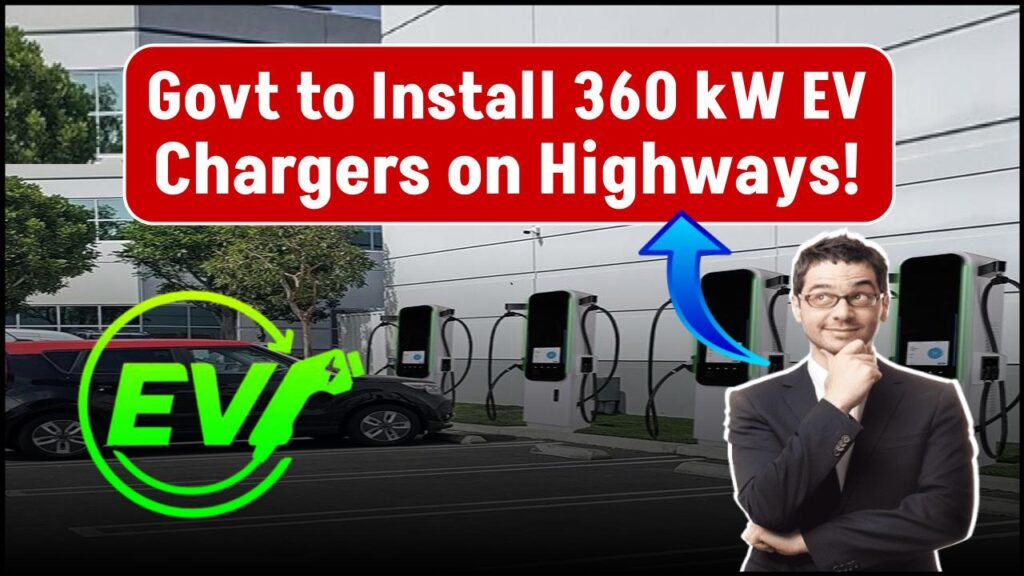Govt to Install 360kW EV Chargers: The Indian government is making a major move to boost the electric vehicle (EV) ecosystem by installing 360kW DC fast chargers across national highways, expressways, and key bus depots. This is a game-changing step, especially for heavy-duty electric vehicles like e-buses and e-trucks, and even for high-end EVs like those from Jaguar, BMW, and Mercedes-Benz. Currently, most EV chargers in public use provide just 30-60kW, which means drivers often wait up to an hour to fully charge. But 360kW chargers will slash that time down to 15–20 minutes, making EV usage far more practical and efficient, particularly for commercial operators.

Govt to Install 360kW EV Chargers
| Feature/Detail | Description |
|---|---|
| Charger Power | 360kW DC Fast Chargers |
| Charging Time | ~15 minutes for compatible EVs |
| Target Users | Heavy-duty EVs (buses, trucks), premium EVs |
| Installation Sites | Highways, STU bus depots, expressways |
| Funding | ₹2,000 crore under PM E-Drive Scheme |
| Charging Standard | CCS (Combined Charging System) |
| Official Source | Government of India Ministry of Heavy Industries |
The government’s plan to deploy 360kW EV chargers across highways is more than just a tech upgrade—it’s a major leap towards a cleaner, smarter, and faster transportation future. From drastically reducing wait times to boosting commercial efficiency and encouraging EV adoption, the benefits are transformative. As India charges ahead with innovation, these powerful chargers will light the way.
Why 360kW Chargers Matter for Heavy-Duty EVs
Imagine running a logistics company with 100 electric trucks. If each truck needs an hour to charge, you lose valuable time—and time is money. With 360kW chargers, those trucks can be charged in just 15–20 minutes, meaning less downtime, more deliveries, and better profits. For public transport, e-buses can stay on schedule without long charging breaks. This efficiency helps boost the confidence of city authorities and private players to invest more in electric fleets. Moreover, these ultra-fast chargers can also serve high-end personal EVs that support rapid charging, turning long-distance trips into a real possibility.
Where Will These Chargers Be Installed?
According to Angel One, the Indian government plans to roll out 1,800 charging stations as part of the PM Electric Drive Revolution in Innovative Vehicle Enhancement (PM E-Drive) scheme. These will be placed at:
- State Transport Undertaking (STU) depots
- Major expressways and highways
- Key intercity transit corridors The goal is to create an interconnected grid where heavy-duty EVs can travel long distances without range anxiety.
Technical Compatibility and Standards
All 360kW charging stations will follow the CCS (Combined Charging System) standard—one of the most widely accepted global standards. CCS supports both AC and DC fast charging, and is used by brands like Hyundai, BMW, Tata Motors, and Mercedes-Benz. This standardization ensures that both commercial and premium EVs can charge without any hiccups, creating a unified, scalable infrastructure. Learn more about CCS on Wikipedia.
Govt to Install 360kW EV Chargers: How This Impacts India’s EV Ecosystem?
The launch of high-powered chargers comes at a crucial time for India’s EV sector. Here’s what it means:
1. Accelerated Fleet Electrification
Fleet operators, especially in logistics and public transport, will now find it economically viable to switch to EVs. Faster charging means more uptime.
2. Consumer Confidence Boost
With more charging options and less wait time, more consumers may choose electric vehicles, especially in tier 1 and tier 2 cities.
3. Environmental Impact
As per NITI Aayog, switching to EVs could cut 1 gigaton of carbon emissions by 2030. Ultra-fast charging supports this green vision.
4. Global Investment Appeal
Robust infrastructure makes India an attractive destination for global EV makers like Tesla, BYD, and Rivian looking to enter or expand in the market.
Practical Advice: How to Prepare for the 360kW Charging Rollout
If you are a fleet manager, EV owner, or planning to switch, here are some tips:
Step 1: Check EV Compatibility
Not all EVs can accept 360kW charging. Ensure your vehicle supports high-power DC fast charging.
Step 2: Route Planning
Use apps like PlugShare or Tata EZ Charge to map existing and upcoming charging stations.
Step 3: Upgrade Business Fleets
For logistics and transport businesses, consider upgrading to heavy-duty EVs with fast-charge compatibility.
Step 4: Educate Your Team
Fleet operators should train staff on charging protocols, safety standards, and maintenance tips.
Buying Electric Vehicle Insurance? — Check 5 Key Factors Before You Choose a Policy
AVNL Recruitment 2025 Begins – Check Eligibility & Apply Fast!
FAQs on Govt to Install 360kW EV Chargers
Q1: How fast is a 360kW EV charger?
A: It can charge compatible EVs from 20% to 80% in 15–20 minutes.
Q2: Who can use these chargers?
A: Primarily designed for buses and trucks, but also compatible with premium EVs supporting CCS.
Q3: Are there any safety concerns?
A: These chargers follow international safety standards and are completely safe when used properly.
Q4: Will it cost more to use 360kW chargers?
A: Pricing will depend on service providers but is expected to be competitive due to faster turnaround.
Q5: When will this rollout be completed?
A: The timeline aligns with India’s 2030 EV penetration target, but initial stations may appear as early as 2025.





